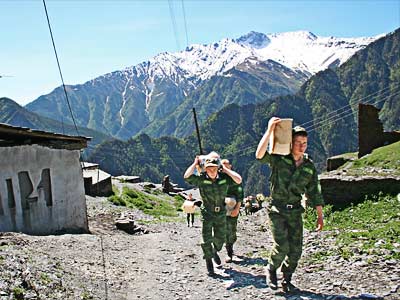
Once-Dominant Ethnic-Russian Community in Northern Dagestan Disappearing
By:

Ethnic Russians have never formed a major proportion of the population of Dagestan, the most Islamic of the republics within the Russian Federation. Their greatest number and highest share were recorded in the 1959 census, when there were 213,754 Russians, who together made up 20.1 percent of the population. That figure fell to 120,875, or 4.7 percent, in 1989, and 104,020 (3.6 percent) in 2010. The number of Russians has fallen still further in the last several years.
Yet, those figures are for the republic as a whole. Historically, Russians have formed much larger proportions in the republican capital of Makhachkala and in the northwestern portion of Dagestan. In the last five years, however, the Russian community in the northwest has collapsed, and the Russian presence in the capital has fallen as well. In the short term, the disappearance of the once-thriving Russian community in the northwest may be even more significant, not only because it eliminates one of the levers Moscow has used to control the inter-ethnic situation there and in neighboring Chechnya and Ingushetia, but also because it reduces the ethnic Russians to a colonial-style presence in Makhachkala surrounded by a rapidly growing non-Russian and non-Christian majority.
Moscow journalist Yury Soshin has been monitoring this trend for more than a decade. He says that the Russian decline, which slowly emptied the villages in the northwest of ethnic Russians and Cossacks, has now accelerated and is leading to a precipitous fall in the number and share of ethnic Russians in the three largest cities in the region: Khasavyurt, Kizlyar and Tarumovka. The proximate cause of this acceleration, he suggests, was the attack on a Russian church in Kizlyar in February 2018, in which a Muslim fanatic killed five Russian Orthodox congregants. No longer feeling secure in their homes, Russians have fled since that time (APN, November 13, 2017; April 24, 2018); December 31, 2018).
Khasavyurt, Soshin says, has been “completely de-Russified,” and the other two cities are close to that point, a development that sends a message to all the people of Dagestan and indeed the North Caucasus that the Russians are going home and that their future lies elsewhere. Even the appointment of an ethnic Russian to head the republic has done little to stem the growth of such feelings. Indeed, it looks more like an empire’s last act of desperation than a real attempt to integrate the people of Dagestan and the region into the “non-ethnic Russian nation” the Kremlin talks so much about.
But there is a far more immediate danger, one that is likely to explode this spring and summer. The mass departure of ethnic Russians from northwestern Dagestan has created a vacuum that Chechnya’s Ramzan Kadyrov wants to fill. Kadyrov has made no secret of the fact that he would like to supervise the Chechen community in northwestern Dagestan and even incorporate part of that republic into his own (Windowoneurasia2.blogspot.com, Kavkavsky Uzel, December 10, 2018; see EDM, September 27, 2018).
Members of his own government and representatives of the Chechen community in Dagestan have echoed this desire (Ndelo.ru, December 1, 2018; The Caucasus Post, December 4, 2018). With the departure of the ethnic-Russian community from this part of Dagestan, Kadyrov seems certain to step up this effort. And quite possibly, this might trigger the kind of conflict Ingushetia has been mired in since he and Ingushetia’s Yunus-Bek Yevkurov agreed, on September 26, to shift the borders there in Chechnya’s favor.



